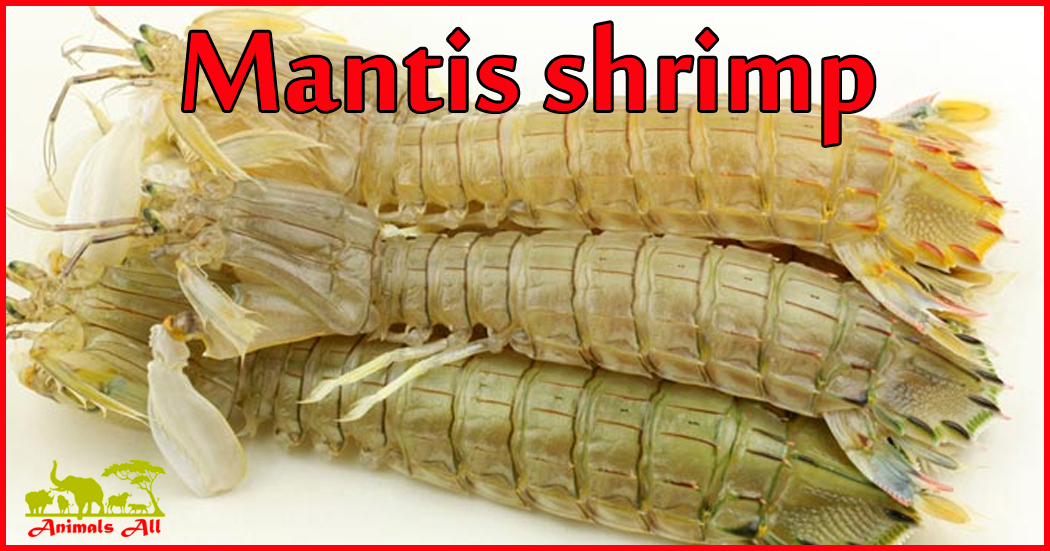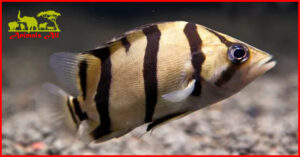
Let’s know some about mantis shrimp
Mantis shrimp is commonly know as “mantis shrimps”, “crawlers”, “crawler shrimps”, ” shrimp crawlers “, “skin shrimps”, etc. They are a general term for species of the phylum Arthropoda , subphylum Crustacea , class Molacaceae , subclass Prawns , and order Stomatopoda. There are currently nearly 500 species in seven superfamilies, most of which live in tropical and subtropical waters, and a few are found in temperate waters. Among them, the wide-temperature species of the genus Oratosquilla, family Squillidae, is distributed along the worldwide.
Morphological characteristics
The mantis shrimp is also known as the Oriental mantis shrimp. The head and the first four segments of the abdomen are fused, and the cephalothorax and thoracic segments are distinct on the back. The abdomen has seven segments, and the boundaries are also obvious. It is larger and wider than the head and thorax. There is a pair of large, stalked compound eyes at the front of the head, and two pairs of antennae.
The top of the first pair of internal limbs is divided into three whip-like limbs, and the second pair of external limbs are scaly. There are five pairs of appendages on the chest, with sharp hooks at the end to catch food. The abdomen has six segments, and the appendages of the first five segments have gills. The sixth pair of abdominal limbs are well developed and form a tail fan with the tail segment. The male shrimps are dioecious, and the male has a copulatory organ at the last segment of the chest
Origin Distribution
Origin and Season: Mantis shrimp is a coastal and nearshore species. Mantis shrimp likes to live in shallow mud and sand or reef cracks. It is distributed along the coasts of north and south China. The mouth mantis shrimp is a species unique to the Bohai Bay . It has a large output. According to surveys and statistics from 1982 to 1983, the annual output is about 2,500 tons. The resource volume is about 5,000 tons or more. The production period is from April to May every year. The distribution range of the mouth mantis shrimp is extremely wide, from the Great Peter Bay in Russia to Japan and the coast of China, the Philippines , the Malay Peninsula , and the Hawaiian Islands .
Economic Value
Mantis shrimp are delicious and inexpensive, making them a popular seafood product for coastal residents and a popular delicacy on the tables of hotels and restaurants in coastal cities. The best time to eat mantis shrimp is between April and June, when the shrimp is at its most tender. Generally speaking, female mantis shrimp are not as big as male ones. Another way to distinguish between male and female is that female mantis shrimp usually have a white character on their
Just like choosing fish, if the shrimp is shiny and green, it is fresh. If it is dark and dull, it is not fresh. In addition, you can also look at the shrimp head. If the shrimp head is soft and looks like it is about to fall off, it is not fresh. You can also look at the shrimp claws. If the claws are red, they are not fresh. Only if they are green are good.
Although dead mantis shrimps are still edible, if they are soft and red when you buy them, they are not fresh and it is best not to buy them. There are many ways to eat mantis shrimps . Whether it is raw shrimp chips, oil-soaked shrimp chips (shelled and meat slices), pepper salt , soy sauce or steamed(steamed, steamed with garlic, steamed with scallion oil), blanched, fried, boiled or used for scrambled eggs, fried rice, porridge , etc., they can all be made into mouth-watering delicacies. Even if you only boil them with white water and salt, they are delicious and popular. In addition, their eggs can be processed into shrimp roe, which is a traditional fresh seasoning. When choosing mantis shrimps, you must pay attention to the freshness.
Shiny shells
The shells of fresh mantis shrimps are green and shiny, and they are firm and elastic when pressed by hand. The color of dying or dead mantis shrimps is grayish yellow and dull. The edible quality of mantis shrimps is generally better in deep water areas. Mantis shrimps, especially deep-water ones, die soon after leaving the water. They are extremely difficult to keep alive and their meat is watery and easily loses its freshness (hence people in the Chaoshan area often pickle fresh mantis shrimps with salt and eat them raw or steamed after pickling). Therefore, fresh mantis shrimps are generally considered the best quality, while dead ones with a firm body and no peculiar smell are better.
Nutritional Value
Mantis shrimp is a nutritious seafood food with fresh and tender meat. Its meat contains a lot of water, and its meat is sweet, tender, light and soft, and has a special and attractive flavor. Spring is the season for spawning, and it is best eaten at this time. The brain of a fat mantis shrimp is full of fat , and its meat is very tender and delicious. But unfortunately, it has more shell than meat. However, its protein content is as high as 20%, fat 0.7%, as well as vitamins , chloric acid , inosinic acid , aminopropionic acid. Other nutrients needed by the human body. Mantis shrimp is warm in nature and sweet in taste. It has the effects of nourishing the kidney and strengthening yang , promoting lactation and detoxification.
Delicious meat

Mantis shrimps have delicious meat, and the entire abdomen of sexually mature individuals is filled with nutritious reproductive glands. They live in caves, which can not only avoid the heat and cold. But also reduce losses caused by typhoons and other catastrophic weather. They also have advantages over other aquaculture species. Such as strong disease resistance, and can be used as an important species in the screening of new aquaculture species. According to measurements, the dry weight of mantis shrimps contains 72.12% protein, 7.88% fat, 7.91% ash , 0.38% calcium , and 2.21% phosphorus.
They have a comprehensive amino acid content and a reasonable composition. Which is easy for the human body to digest and absorb. In particular, they have a high content of essential amino acids such as lysine. They are rich in glutamic acid and glycine , so they taste delicious when eaten. Due to the low amount of natural resources and overfishing of marine fishery resources, mantis shrimp resources have seriously declined.
In addition, since 2010, the aquaculture of shrimp, scallops and other species has been seriously affected by diseases, causing the aquaculture industry to decline. In addition, artificial fishing of mantis shrimp cannot meet market demand, causing its price to rise day by day. Therefore, conducting research on artificial breeding and cultivation technology of mantis shrimp and developing this new aquaculture species will produce significant economic, social and ecological benefits.
Nutritional characteristics
- 1.
- 2.Shrimp is rich in nutrients, and its meat is soft and easy to digest, making it a great choice for people who are weak or need to recover from illness.
- 3.Shrimp is rich in magnesium, which plays an important role in regulating heart activity and can protect the cardiovascular system. It can reduce the cholesterol content in the blood, prevent arteriosclerosis , and dilate the coronary arteries, which is beneficial for preventing hypertension and myocardial infarction.
- 4.Shrimp has a strong lactation effect and is rich in phosphorus and calcium, which is especially beneficial for children and pregnant women .
- 5.Scientists at Osaka University in Japan recently discovered that astaxanthin in shrimp can help eliminate jet lag, a condition caused by time differences.
Pharmacological effects
Precautions
Avoid eating shrimp with certain fruits. Shrimp is rich in nutrients such as protein and calcium. If you eat them with fruits containing tannic acid, such as grapes , pomegranates , hawthorns , persimmons , etc. It not only will the nutritional value of the protein be reduce, but the tannic acid and calcium ions will combine to form insoluble compounds that irritate the stomach and intestines, causing discomfort to the human body, vomiting , dizziness, nausea, abdominal pain, diarrhea, etc. There should be at least 2 hours between eating seafood and these fruits.
Dosage
Try not to eat red, soft, and drooping shrimps that are not fresh. Do not eat rotten or spoiled shrimps. The shrimp thread on the back of the shrimp should be pick out and not eaten.
Edible effects
Seawater shrimps are moist in nature, sweet and salty in taste, and enter the kidney and spleen meridians. Shrimp meat has the effects of nourishing the kidney and strengthening yang, promoting lactation and resisting toxins, nourishing blood and consolidating essence, removing blood stasis and detoxifying, invigorating qi and nourishing yang, unblocking meridians and relieving pain, and stimulating appetite and resolving phlegm.
It is suitable for patients suffering from kidney deficiency, impotence, spermatorrhea, premature ejaculation , milk blockage, muscle and bone pain, hand and foot cramps, general itching, skin ulcers, physical weakness and neurasthenia .
Farming technology
Mantis shrimp live in water layers 5 to 60 meters deep, and prefer to live in U-shaped caves on shallow mud bottoms or in cracks in gravel and reefs. The males and females are dioecious, but they are similar in appearance. The difference is that the males are slightly larger, and the last pair of legs on the chest are different in shape. The second maxillary leg of the male is thick, and there is a pair of rod-shaped copulatory organs on the inner side of the base of the last pair of legs on the chest. Very few seventh thoracic limbs also have a copulatory organ. Females do not have it. During the breeding season, white “king”-shaped gelatinous glands appear on the ventral surface of the 6th to 8th thoracic segments of the female chest.
Sexual maturity in one year, most scholars believe that the mating time is before the female mantis shrimp molts from September to November. Some people believe that the legs mate shortly before spawning. Some believe that they have mated a few months before spawning. Generally, mating occurs once, and mating again also occurs from time to time. Its breeding season is from April to September, and the peak season is from May to July. During the breeding season, the ovary is yellow-brown from the 4th to the tail segment of the chest, with melanin distributed on the back. The pigment is more concentrated on the midline of the body axis. The thickness of the ovary is the largest at the 5th and 6th segments. It is enlarge at the tail segment, filling the tail segment and forming a fan shape.

